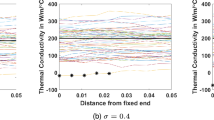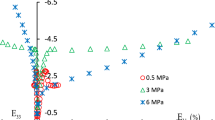Abstract
Numerical simulation of the polyurethane foaming process is a valuable method to analyze the molding process at an early stage of product development to shorten time-to-market cycles and cut costs by using fewer prototypes. However, this process involves highly coupled thermo-chemo-rheological modeling and needs adequate model parameters’ identification. A theoretical model including chemical reactions and thermo-rheological coupling of conservation equations was developed. Based on the theoretical model, three-dimensional numerical simulation for mold filling of the polyurethane foam was carried out by using Finite Pointset Method (FPM) to predict flow field, flow front advancement, temperature and density distributions during mold filling. A FOAMAT system was used to monitor foam height rise and reaction temperature on a cylindrical test tube and foam viscosity was measured by using a dynamic rotational rheometer with parallel-plate system. The parameters of the model were identified by an inverse analysis method which consists in determining the parameters by comparing the computed quantities to those measured experimentally. The overall modeling was validated by using short shot foams obtained with a panel mold cavity. Mold filling of an automotive underlay carpet cavity was investigated numerically. Flow front results were successfully compared to short shot foams obtained with the industrial mold cavity.






















Similar content being viewed by others
References
Epstein PS, Plesset MS (1950) On the stability of gas bubbles in liquid-gas solutions. J Chem Phys 18:1505
Chang DH, Hee JY (1981) Studies on structural foam processing. IV. Bubble growth during mold filling. Polym Eng Sci 21:518
Amon M, Denson CD (1984) A study of the dynamics of foam growth: Analysis of the growth of closely spaced spherical bubbles. Polym Eng Sci 24:1026
Amon M, Denson CD (1986) A study of the dynamics of foam growth: Simplified analysis and experimental results for bulk density in structural foam molding. Polym Eng Sci 26:255
Arefmanesh A, Advani SG, Michaelides EE (1990) A numerical study of bubble growth during low pressure structural foam molding process. Polym Eng Sci 30:1330
Arefmanesh A, Advani SG (1995) Nonisothermal bubble growth in polymeric foams. Polym Eng Sci 35:252
Gregory AC (1972) Polyurethane foam process development. A systems engineering approach. J Appl Polym Sci 16:1387
Yokono H, Tsuzuku S, Hira Y, Gotoh M, Miyano Y (1985) Simulation of foaming process of polyurethane integral skin foams. Polym Eng Sci 25:959
Rojas AJ, Marciano JH, Williams RJ (1982) Rigid polyurethane foams: A model of the foaming process. Polym Eng Sci 25:840
Lee WH, Lee SW, Kang TJ, Chung K, Youn JR (2002) Processing of polyurethane/polystyrene hybrid foam and numerical simulation. Fiber Polym 3:159
Baser SA, Khakhar DV (1994) Modeling of the Dynamics of Water and R-11 blown polyurethane foam formation. Polym Eng Sci 34:642
Bikard J, Bruchon J, Coupez T, Vergnes B (2005) Numerical prediction of the foam structure of polymeric materials by direct 3D simulation of their expansion by chemical reaction based on a multidomain method. J Mater Sci 40:5875
Bikard J, Bruchon J, Coupez T, Silva L (2007) Numerical simulation of 3D polyurethane expansion during manufacturing process. Colloids Surf A 309:49
Bouayad R, Bikard J, Agassant JF (2009) Compressible flow in a plate/plate rheometer: application to the experimental determination of reactive expansion’s models parameters for polyurethane foam. Int J Mater Form 2:243
Baser SA, Khakhar DV (1994) Modeling of the dynamics of R-11 blown polyurethane foam formation. Polym Eng Sci 34:632
Lefebvre L, Keunings R (1993) Published. In: Cross M, Pittman JFT, Wood RD (eds) Mathematical modeling for materials processing. Clarendon, Oxford, p 399
Lefebvre L, Keunings R (1995) Finite element modelling of the flow of chemically reactive polymeric liquids. Int J Numer Meth Fl 20:319
Dimier F, Sbirrazzuoli N, Vergnes B, Vincent M (2004) Curing kinetics and chemorheological analysis of polyurethane formation. Polym Eng Sci 44:518
Piloyan GO, Ryabchikov ID, Novikora OS (1966) Determination of Activation Energies of Chemical Reactions by Differential Thermal Analysis. Nature 212:1229
Geier S, Winkler C, Piesche M (2009) Numerical Simulation of Mold Filling Processes with Polyurethane Foams. Chem Eng Technol 32:1438
Lipshitz SD, Macosko CW (1977) Kinetics and energetics of a fast polyurethane cure. J Appl Polym Sci 21:2029
Kuhnert J (1999) General smoothed particle hydrodynamics. PhD Thesis, University of Kaiserslautern, Germany
Sherman P (1962) The viscosity of emulsions. Rheol Acta 2:74
Serrano D, Peyrelasse J, Boned C, Harran D, Monge P (1990) Application of the percolation model to gelation of an epoxy resin. J Appl Polym Sci 39:679
Lucy LB (1977) A numerical approach to the testing of the fission hypothesis. Astron J 83:1013
Li S, Liu WK (2007) Meshfree particle methods. Springer, Berlin
Randles PW, Libersky LD (1996) Smoothed Particle Hydrodynamics: Some recent improvements and applications. Comput Methods Appl Mech Eng 139:375
Belytschko T, Lu YY, Gu L (1994) Element-free Galerkin methods. Int J Numer Methods Eng 37:229
Chen JS, Pan C, Wu CT, Liu WK (1996) Reproducing Kernel Particle Methods for large deformation analysis of non-linear structures. Comput Methods Appl Mech Eng 139:195
Lancaster P, Salkauskas K (1981) Surfaces generated by moving least squares methods. Math Comput 37:141
Oñate E, Idelsohn S, Zienkiewicz OC, Taylor LR, Sacco C (1996) A stabilized finite point method for analysis of fluid mechanics problems. Comput Methods Appl Mech Eng 139:315
Moeller A, Kuhnert J (2007) Simulation of the glass flow inside a floating process. Verre 13:28
Uhlmann E, Gerstenberger R, Kuhnert J (2013) Cutting Simulation with the Meshfree Finite Pointset Method. Procedia CIRP 8:391
Trameçon A, Kuhnert J, Mouchette L, Perrin M (2011) New Trends in Accurate Simulations for the Verification of Safety Margins in the Nuclear Power Plant Industry: Application of Virtual Performance Solution™ for the Response of Immersed Structures Subjected to Earthquakes. ASME Proc 4:409
Chorin AJ (1968) Numerical solution of the Navier-Stokes equations. Math Comput 22:745
Ivankovic M, Incarnato L, Kenny JM, Nicolais L (2003) Curing kinetics and chemorheology of epoxy/anhydride system. J Appl Polym Sci 90:3012
Deb K, Pratap A, Agarwal S, Meyarivan T (2002) A fast and elitist multiobjective genetic algorithm: NSGA-II. IEEE Trans Evol Comput 6:182
Acknowledgments
The financial support of the European Union and the Champagne-Ardenne Region is gratefully acknowledged. This work was also supported by the HPC Centre of Champagne-Ardenne ROMEO.
Author information
Authors and Affiliations
Corresponding author
Rights and permissions
About this article
Cite this article
Abdessalam, H., Abbès, B., Li, Y. et al. Parameter identification and computational simulation of polyurethane foaming process by finite pointset method. Int J Mater Form 9, 85–100 (2016). https://doi.org/10.1007/s12289-014-1210-y
Received:
Accepted:
Published:
Issue Date:
DOI: https://doi.org/10.1007/s12289-014-1210-y




